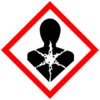5.4 Toxics (CMR)
Numerous chemicals have a toxic effect on the human body. Therefore, every substance should be treated as though it were toxic. The greatest possible care and cleanliness should be observed during laboratory work.
In accordance with the Environmental Code´s substitution principle (SFS 1998:808, Chapter 2, Section 4) chemical products that are hazardous to health and environment are to be substituted, by substances that are less hazardous, through active product selection and substitution. In accordance with the law, there is to be a phase out of products that consist of or contain:
- CMR substances (Carcinogenic, Mutagenic or Reproductive toxicants)
- Halogenated solvents, which are PBT or vPvB substances (persistent, bioaccumulative and toxic or very persistent and very bioaccumulative)
- Particularly hazardous metals such as e. g. Cd, Hg, and Pb.
A substitution investigation must be performed before work with the above mentioned substances. For information and form for substitution in Swedish, go to: Substitution och reducering av hälso- och miljöfarliga produkter | HR-webben.
CMR substances
Carcinogens are chemical or physical agents that cause cancer. Generally they are chronically toxic substances, that is, they cause damage after repeated or long-duration exposure, and their effects may only become evident after a long latency period.
Regulations concerning the handling of carcinogenic substances have been issued by the Swedish Work Environment Authority. The most carcinogenic substances are divided into two categories, category A and category B. Both categories require permission to use.
Substances for which permission is required
Category A chemicals - Swedish Work Environment Authority
Category B chemicals - Swedish Work Environment Authority
According to the Swedish Work Environment Authority´s provision "Chemical hazards in the Working Environment" (AFS2011:19 Section 39) CMR substances are only to be handled after a documented investigation has been carried out that shows that it is technically impossible to replace the product with a less hazardous alternative.
If the investigation shows that substitution for less hazardous chemical is not possible, try to minimize the amount of hazardous chemical instead by:
- Working in smaller scale, make fewer experiments
- Limiting the amount of chemicals by discarding old chemicals, those that are not used
- Ordering smaller quantities when purchasing
- Purchasing kit and ready-made solutions instead of pure and concentrated chemicals/substances
Substances for which no permission is required
Substances for which no permission is required follows by exposure limit values according to "Hygieniska gränsvärden" (Provision AFS 2018:1) "Occupational exposure limit values list" where the full list is available. In the list of chemicals with hygienic limits (AFS 2018:1), indicates if the substance belongs to a following categories:
- Carcinogenic substances are denoted by C.
- Substances easily absorbed through skin are denoted by H.
- Substances that might require a medical examination prior use are denoted by M.
- Sensitizing substances are denoted by S.
- Substances posing a danger to reproduction are denoted by R.
- Indicative short-term limit value are denoted by V.
Allergenic substances
An allergen is a substance that causes exposed individuals to develop an allergic reaction in normal tissue after repeated exposure to the substance. Chromium, nickel, cobalt, mercury and their salts, formalin, certain types of plastic, paint, and film, especially epoxy, can cause an allergic reaction, usually in the form of eczema. Be careful and observe good hand hygiene.
Allergenic substances are denoted with an S in the ‘Occupational exposure limit values list’ (AFS 2018:1) and marked with the following risk phrases (hazard statements).
- H317
- H334
When handling allergenic substances education is required.
Narcotic substances
There are special requirements concerning import, export, handling, and storing certain substances, which may be used to manufacture narcotics. Permission or registration is required for specific narcotic substances. The list is available at the Swedish Medical Products Agency website: Narcotic drugs - Swedish Medical Products Agency


Depending on toxicity, should toxic material be marked with one or both of these labels.

Cupboards containing toxic material should be marked with this label.
